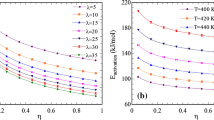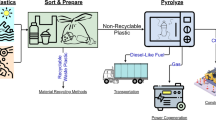Abstract
Terephthalic acid (TPA) was prepared from waste polyethylene terephthalate by microwave-assisted depolymerization with TOMAB as catalyst, the structure and properties of TPA were elucidated by using physico-chemical and spectroscopic methods. Single-factors experiments demonstrated that the TPA yield was affected significantly by the factors of catalyst and alkali amount, depolymerization temperature and time. The effects of variables, including catalyst and alkali amount, depolymerization temperature and time, on the TPA yield were evaluted by response surface methodology with a Box-Behnken design. The modified and verified experiments were completed after considering product performance and actual operation, the optimum parameters were determined to be TOMAB 2.7 g, 15% NaOH 260 mL, temperature 85 °C, degradation time 2.2 h. Under these conditions, the average yield of TPA in three replicated experiments is 97.53%, and this value is not significantly different from the value of 98.59% predicted by the model. These results demonstrate that this method is feasible.








Similar content being viewed by others
References
Sadeghi GMM, Shamsi R, Sayaf M (2011) From aminolysis product of PET waste to novel biodegradable polyurethanes. J Polym Environ 19:522–534
Loic B, Tamara E, Thierry M, Arnaud P, Maurice B, Benedicte L, Philippe R (2009) Atom transfer radical polymerization of styrene from different poly(ethylene terephthalate) surfaces: films, fibers and fabrics. Eur Polym J 45:246–255
Yusuf N, Demet C, Ioan C, Yusuf Y, Jale H (2008) Pyrolysis of poly(phenylene vinylene)s with polycaprolactone side chains. Polym Degrad Stab 93:904–909
Donnini MS, Maria Z (2007) Post consumer pet depolymerization by acid hydrolysis. Polym Plast Technol Eng 46:135–144
Karayannidis GP, Nikolaidis AK, Sideridou ID, Bikiaris DN, Achilias DS (2006) Chemical recycling of PET by glycolysis: polymerization and characterization of the dimethacrylated glycolysate. Macromol Mater Eng 291:1338–1347
Pardal F, Tersac G (2006) Comparative reactivity of glycols in PET glycolysis. Polym Degrad Stab 91:2567–2578
Pingale ND, Shukla SR (2009) Microwave-assisted aminolytic depolymerization of PET waste. Eur Polym J 45:2695–2700
Bech L, Meylheuc T, Lepoittevin B, Roger P (2007) Chemical surface modification of poly(ethylene terephthalate) fibers by aminolysis and grafting of carbohydrates. J Polym Sci A Polym Chem 45:2172–2183
Mohammad NS, Dimitris SA, Halim HR, Dimitris NB, Konstantins-Alexandros GK, George PK (2010) Hydrolytic depolymerization of PET in a microwave reactor. Macromol Mater Eng 295:575–584
Lidstrom P, Tierney J, Wathey B, Westman J (2001) Microwave assisted organic synthesis—a review. Tetrahedron 57:9225–9283
Bogdal D, Penczek P, Pielichowski J, Prociak A (2003) Microwave assisted synthesis, crosslinking, and processing of polymeric meterials. Adv Polym Sci 163:193–263
Hammi KM, Jdey A, Abdelly C, Majdoub H, Ksouri R (2015) Optimization of ultrasound-assisted extraction of antioxidant compounds from Tunisian Zizyphus lotus fruits using response surface methodology. Food Chem 184:80–89
Mohammad NS, Dimitris SA, Halim HR, Dimitris NB, Konstantinos-Alexandros GK, George PK (2010) Hydrolytic depolymerization of PET in a microwave reactor. Macromol Mater Eng 295:575–584
Xiao C, Fusheng L, Zhuo L, Shitao Y (2010) Hydrolysis of poly(ethylene terephthalate) to recover terephthalic acid in ionic liquids. Chem Eng 38:40–44
Acknowledgements
We acknowledge the financial support from the Qingyang City Science and Technology Support Project (No. KZ2012-56) and the Applied Chemistry Key Subject of Gansu Province (No. GSACKS20130113), PR China.
Author information
Authors and Affiliations
Corresponding author
Rights and permissions
About this article
Cite this article
Hu, H., Wu, Y. & Zhu, Z. Optimization of Microwave-Assisted Preparation of TPA from Waste PET Using Response Surface Methodology. J Polym Environ 26, 375–382 (2018). https://doi.org/10.1007/s10924-017-0952-2
Published:
Issue Date:
DOI: https://doi.org/10.1007/s10924-017-0952-2




